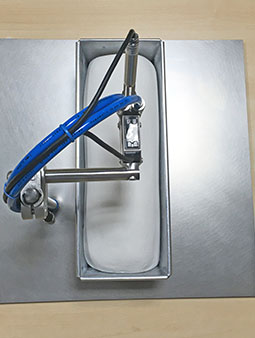
Kaak is working to improve the future of iBake Care and to offer additional benefits to customers by researching new technologies. One such technology is called “Dough Sense” that would provide real-time feedback on dough quality.
The idea behind Dough Sense is that it could replace the baker’s fingers when feeling the dough for quality. It would provide a value to what a baker “feels” when they press on the dough.
Dough Sense technology uses a sensor combined with a burst of air, a camera, and a laser to measure the initial height of the dough and the return depth after a low pressure air burst. It captures measurements at the beginning, middle and final depth of the proofer. This provides values for the deformation and relaxation of the dough. Using these measurements, the Dough Sense calculates the elasticity and viscosity to evaluate the viscoelastic properties of the dough. This provides continuous and real-time values about how the dough is behaving. It could potentially identify any changes in the dough and alert the baker to an issue with the recipe or the environment for a batch of dough. Dough Sense could help ensure consistency from batch to batch and identify any deviations from target product.
The sensor is currently being tested on the proofer side, but the idea is that this could be placed in other parts of the process. The sensor could be placed anywhere in process where the dough can stop moving for a couple of seconds. At different locations in the process, it could help identify different changes, like if there was a change in the dough due to ingredients, recipe or due to the mixing process.

Currently, the technology is being validated and will need more work to validate various recipe and environmental changes, and on various types of dough. This includes more research to see how gluten free doughs would behave with this technology. There are some challenges that could also affect the data gathered including, for example, if the dough was not placed in the middle of the tin, if the dough was folded, or if in a strange shape.
This technology is not ready for market as it is still in the early stages of development, and needs more research to ensure effectiveness across various recipe changes and dough types. In the future, this technology could be a valuable tool for a baker to ensure they are producing a consistent, quality product every batch, every day.


